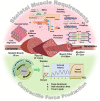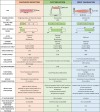Contractile force assessment methods for in vitro skeletal muscle tissues
- PMID: 35604384
- PMCID: PMC9126583
- DOI: 10.7554/eLife.77204
Contractile force assessment methods for in vitro skeletal muscle tissues
Abstract
Over the last few years, there has been growing interest in measuring the contractile force (CF) of engineered muscle tissues to evaluate their functionality. However, there are still no standards available for selecting the most suitable experimental platform, measuring system, culture protocol, or stimulation patterns. Consequently, the high variability of published data hinders any comparison between different studies. We have identified that cantilever deflection, post deflection, and force transducers are the most commonly used configurations for CF assessment in 2D and 3D models. Additionally, we have discussed the most relevant emerging technologies that would greatly complement CF evaluation with intracellular and localized analysis. This review provides a comprehensive analysis of the most significant advances in CF evaluation and its critical parameters. In order to compare contractile performance across experimental platforms, we have used the specific force (sF, kN/m2), CF normalized to the calculated cross-sectional area (CSA). However, this parameter presents a high variability throughout the different studies, which indicates the need to identify additional parameters and complementary analysis suitable for proper comparison. We propose that future contractility studies in skeletal muscle constructs report detailed information about construct size, contractile area, maturity level, sarcomere length, and, ideally, the tetanus-to-twitch ratio. These studies will hopefully shed light on the relative impact of these variables on muscle force performance of engineered muscle constructs. Prospective advances in muscle tissue engineering, particularly in muscle disease models, will require a joint effort to develop standardized methodologies for assessing CF of engineered muscle tissues.
Keywords: contractile force; neuroscience; skeletal muscle; stimulation; tissue engineering.
© 2022, Vesga-Castro et al.
Conflict of interest statement
CV, JA, AV, JP No competing interests declared
Figures







Similar articles
-
In vitro drug testing based on contractile activity of C2C12 cells in an epigenetic drug model.Sci Rep. 2017 Mar 16;7:44570. doi: 10.1038/srep44570. Sci Rep. 2017. PMID: 28300163 Free PMC article.
-
Preclinical Drug Testing in Scalable 3D Engineered Muscle Tissues.J Vis Exp. 2023 Apr 7;(194). doi: 10.3791/64399. J Vis Exp. 2023. PMID: 37092832
-
Skeletal Muscle Constructs Engineered from Human Embryonic Stem Cell Derived Myogenic Progenitors Exhibit Enhanced Contractile Forces When Differentiated in a Medium Containing EGM-2 Supplements.Adv Biosyst. 2019 Dec;3(12):e1900005. doi: 10.1002/adbi.201900005. Epub 2019 Nov 4. Adv Biosyst. 2019. PMID: 32648685
-
Residual force enhancement after stretch in striated muscle. A consequence of increased myofilament overlap?J Physiol. 2012 Mar 15;590(6):1339-45. doi: 10.1113/jphysiol.2011.222729. Epub 2012 Feb 13. J Physiol. 2012. PMID: 22331422 Free PMC article. Review.
-
Methodological considerations in measuring specific force in human single skinned muscle fibres.Acta Physiol (Oxf). 2021 Nov;233(3):e13719. doi: 10.1111/apha.13719. Epub 2021 Aug 9. Acta Physiol (Oxf). 2021. PMID: 34286921 Review.
Cited by
-
Dynamic and Static Workout of In Vitro Skeletal Muscle Tissue through a Weight Training Device.Adv Healthc Mater. 2024 Dec;13(32):e2401844. doi: 10.1002/adhm.202401844. Epub 2024 Aug 30. Adv Healthc Mater. 2024. PMID: 39212188 Free PMC article.
-
Engineered nanofibrillar collagen with tunable biophysical properties for myogenic, endothelial, and osteogenic cell guidance.Acta Biomater. 2024 Sep 15;186:95-107. doi: 10.1016/j.actbio.2024.08.002. Epub 2024 Aug 6. Acta Biomater. 2024. PMID: 39117115
-
Optimizing electrical field stimulation parameters reveals the maximum contractile function of human skeletal muscle microtissues.Am J Physiol Cell Physiol. 2025 Apr 1;328(4):C1160-C1176. doi: 10.1152/ajpcell.00308.2024. Epub 2025 Feb 28. Am J Physiol Cell Physiol. 2025. PMID: 40019026 Free PMC article.
-
The Development of an Innovative Embedded Sensor for the Optical Measurement of Ex-Vivo Engineered Muscle Tissue Contractility.Sensors (Basel). 2022 Sep 12;22(18):6878. doi: 10.3390/s22186878. Sensors (Basel). 2022. PMID: 36146227 Free PMC article.
-
Myotube formation on micropatterns guiding by centripetal cellular motility and crowding.Mater Today Bio. 2024 Aug 9;28:101195. doi: 10.1016/j.mtbio.2024.101195. eCollection 2024 Oct. Mater Today Bio. 2024. PMID: 39205872 Free PMC article.
References
-
- Afshar ME, Abraha HY, Bakooshli MA, Davoudi S, Thavandiran N, Tung K, Ahn H, Ginsberg HJ, Zandstra PW, Gilbert PM. A 96-well culture platform enables longitudinal analyses of engineered human skeletal muscle microtissue strength. Scientific Reports. 2020;10:1–16. doi: 10.1038/s41598-020-62837-8. - DOI - PMC - PubMed
-
- Afshar Bakooshli M, Lippmann ES, Mulcahy B, Iyer N, Nguyen CT, Tung K, Stewart BA, van den Dorpel H, Fuehrmann T, Shoichet M, Bigot A, Pegoraro E, Ahn H, Ginsberg H, Zhen M, Ashton RS, Gilbert PM. A 3D culture model of innervated human skeletal muscle enables studies of the adult neuromuscular junction. eLife. 2019;8:e44530. doi: 10.7554/eLife.44530. - DOI - PMC - PubMed
Publication types
MeSH terms
LinkOut - more resources
Full Text Sources
Other Literature Sources

